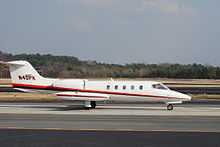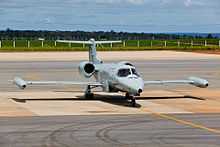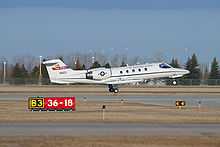Learjet 35
The Learjet Model 35 and Model 36 are a series of American multi-role business jets and military transport aircraft. When used by the United States Air Force they carry the designation C-21A.
The aircraft are powered by two Garrett TFE731-2 turbofan engines. Its cabin can be arranged for 6-8 passengers. The Model 36 has a shortened passenger area in the fuselage, in order to provide more space in the aft fuselage for fuel tanks. It is designed for longer-range mission capability.
The engines are mounted in nacelles on the sides of the aft fuselage. The wings are equipped with single-slotted flaps. The wingtip fuel tanks distinguish the design from other aircraft having similar functions.
Development
The concept which became the LJ35 began as the Learjet 25BGF (with GF referring to "Garrett Fan"), a Learjet 25 with a then-new TFE731 turbofan engine mounted on the left side in place of the 25's General Electric CJ610 turbojet engine. This testbed aircraft first flew in May, 1971.[1] As a result of the increased power and reduced noise of the new engine, Learjet further improved the design, and instead of being simply a variant of the 25, it became its own model, the 35.
Operational history
In 1976 American professional golfer Arnold Palmer used a Learjet 36 to establish a new round-the-world class record of 22,894 miles (36990 km) completed in 57 hours 25 minutes 42 seconds.[2]
Learjet 35s made the bulk of Escuadrón Fénix during the 1982 Falklands War mainly on diversion flights.
Production on the 35/36 series ceased in 1994.[3]
As of January, 2007, the U.S. National Transportation Safety Board database[4] lists 19 fatal accidents for the 35/35A, and two for the 36/36A.
Variants



Learjet 35
The original Model 35 was powered by two TFE731-2-2A engines and was 13 inches longer than its predecessor, the Model 25. First flight of the prototype Model 35 was on 22 August 1973, and the aircraft was FAA certified in July, 1974. It could carry up to eight passengers. There were 64 base-model 35s built.[3]
Learjet 35A
The Model 35A is an upgraded Model 35 with TFE731-2-2B engines and a range of 2,789 miles, with a fuel capacity of 931 US gallons (3,524 L) with refueling accomplished at ground level through each wingtip tank. It was introduced in 1976, replacing the 35. Over 600 35As were built, with a production line that ended with serial number 677, in 1993.[3]
On February 12, 1996, a Learjet 35A piloted by Mark E. Calkins, Charles Conrad, Jr., Paul Thayer, and Daniel Miller completed an around-the-world flight in record time.[5] The record remains standing as of 2011.[6] This aircraft is now on display in Terminal C of Denver International Airport.
Variants

- C-21A
- The C-21A is an "off the shelf" military variant of the Learjet 35A, with room for eight passengers and 42 ft³ (1.26 m³) of cargo. In addition to its normal role, the aircraft is capable of transporting litters during medical evacuations. Delivery of the C-21A fleet began in April 1984 and was completed in October 1985. Dyncorp International provides full contractor logistics support at seven worldwide locations.
There are 38 Air Force active duty aircraft, and 18 Air National Guard aircraft in the C-21A fleet. On 1 April 1997, all continental U.S.-based C-21As were realigned under Air Mobility Command, with the 375th Airlift Wing at Scott Air Force Base, Illinois, as the lead command. C-21As stationed outside the continental United States are assigned to the theater commanders.[7]
- EC-21A
- Not a U.S. military designation. Electronic warfare training version of the Learjet 35A.
- PC-21A
- Not a U.S. military designation. Maritime patrol, anti-submarine warfare version of the Learjet 35A, equipped with a search radar, FLIR, infra-red linescanner, ESM and MAD systems, high-resolution TV, plus a hardpont under each wing, able to carry up to 454-kg (1,000-lb) in weight.
- RC-21A
- Not a U.S. military designation. Reconnaissance version of the Learjet 35A, equipped with a long-range oblique photography cameras, side-looking synthetic aperture radar, podded surveillance camera systems.
- U-36
- A Combat support variant of the Learjet 35A for the Japan Air self Defense Force (JASDF). At least six built.
- Learjet 36
- The Model 36 is essentially identical to the 35, except that it has a larger fuselage fuel tank, giving it 500 miles longer range, but reducing the passenger area's length by 18 inches (0.46 m). It was certified, along with the 35, in July, 1974.
- Learjet 36A
- Like the 35A, the Model 36A has upgraded engines and a higher maximum gross weight. It was introduced in 1976, replacing the 36.[3]
- R-21A
- Not a U.S. military designation. Reconnaissance version of the Learjet 36A, equipped with a long-range oblique photography cameras, SLAR and a surveillance camera system.
- U-21A
- Not a U.S. military designation. Utility transport, training version of the Learjet 36A. Initially known as U-36A1. Equipped with a missile seeker simulator in addition to a radar, avionics, firing training assessment devices, an ejector pylon, a special communications system, a target towing system and a jammer system. Four were built for the Japan Maritime Self-Defense Force. Modification of both the U-36A1 and U-36 was carried out by Shin Meiwa Industry co., Ltd. (SMIC) at it's Tokushima plant.
After-Market Modifications
Raisbeck Engineering offers two after-market modifications to the Learjet 35 and 36 series of aircraft. The Aft Fuselage Locker offered by this company is an external storage container mounted below the rear fuselage that can hold 300 lb of baggage.[8] The addition of the locker imposes no performance penalties on the aircraft. This company also offers the ZR LITE performance improvement package.[9] This modification reduces the cruise drag of the aircraft resulting in 25% less time-to-climb, 3000 to 4000 feet higher initial cruise altitude, .02+ increase in cruise Mach at equal power settings, 1% decrease in N1 and 15° ITT reduction at equal Mach and a 5-10% increase in range.
Avcon Industries also offers two after-market modifications to the Learjet 35 and 36 series of aircraft. The Avcon Fins are delta fins mounted n the aft fuselage, similar to those used on the Learjet 31 which improve directional stability when installed on Lear 35 & 36 models, and eliminate the FAA requirement for operable yaw dampers.[10] The Avcon R/X modifications adds 750 pounds of usable fuel in the tip tanks, which provides up to 40 minutes of additional flight time at normal cruise speeds and altitudes.[11]
Notable accidents and incidents
- On 7 June 1982, Argentine Air Force Learjet 35A serial T-24 was shot down by Sea Dart surface to air missile fired by HMS Exeter during the Falklands War killing all 5 on board.
- On 13 February 1983, a Learjet 35A carrying Sri Lankan business tycoon Upali Wijewardene disappeared (exploded) over the Straits of Malacca (Malaysia). The wreckage has never been found, nor any trace of Wijewardene, his top executives, or crew.[12][13]
- On 15 May 1984, a government-owned Learjet 35A crashed in the sea close to Ushuaia, Argentina during a snowstorm. All 12 people on board were killed.
- On 17 April 1995, a C-21 crashed into a wooded area near Alexander City, Alabama killing the two pilots and six passengers, including Clark G. Fiester, assistant secretary of the Air Force for acquisition, and Major General Glenn A Profitt II.[14]
- The 1996 New Hampshire Learjet crash on Christmas Eve, 24 December 1996, in which a Learjet 35A crashed in New Hampshire, leading to the longest missing aircraft search in that state's history, lasting almost three years, and eventually resulted in Congressional legislation mandating improved emergency locator transmitters (ELTs) be installed in U.S.-registered business jets.
- On 29 August 1999, a U.S. registered Learjet 35A owned by Corporate Jets, Inc., was shot down near Adwa, Ethiopia, while flying from Luxor, Egypt, to Nairobi, Kenya, with the loss of three persons.[15]
- On 25 October 1999, professional golfer Payne Stewart was killed in the crash of a Learjet 35. The plane apparently suffered a loss of cabin pressure at some point early in the flight. All on board are thought to have died of hypoxia, lack of oxygen. The plane, apparently still on autopilot, continued flying until one engine flamed out, most likely due to fuel starvation crashed near Aberdeen, South Dakota after an uncontrolled descent. The exact cause of the pressurization failure and the reason behind the crew's failure or inability to respond to it has not been definitively determined.[16]
- On 2 May 2000, F1 racing driver David Coulthard survived a Learjet 35 crash. His chartered aircraft was traveling from Farnborough Airfield to Côte d'Azur International Airport when it developed engine trouble, and crashed while making an emergency landing at Saint-Exupéry International Airport near Lyon, France. While Coulthard received only minor injuries, the front of the aircraft disintegrated upon impact, killing both pilots.[17][18]
- On 9 March 2006 Argentine Air Force Learjet 35A serial T-21 struck terrain and broke up shortly after takeoff from El Alto International Airport in La Paz, Bolivia killing all 6 on board. The Learjet was sent to Bolivia to deliver humanitarian aid.[19]
- On 4 November 2007, a Learjet 35A crashed in São Paulo, Brazil, after a failed takeoff attempt. It destroyed a house in a residential area near the Campo de Marte Airport, killing the pilot, co-pilot and 6 people of the same family who were in the house.[20]
- On November 19 2013, A Lear Jet 35 crashed in Hollywood, Fl. Killing all 4 on board. This was a medical flight Mexico. This flight crashed at 23:00.
Operators
Civilian operators
The Learjet 35 is operated by private, corporate and air taxi operators.
Military operators
- Japan Maritime Self Defense Force
- Japan Air Self-Defense Force
Specifications (C-21A)
Data from [GlobalSecurity][7]
General characteristics
- Crew: two (pilot and co-pilot)
- Capacity: 8 passengers and 3,153 lb (1,433 kg) of cargo
- Length: 48 ft 7 in (14.81 m)
- Wingspan: 39 ft 6 in (12.04 m)
- Height: 12 ft 3 in (3.71 m)
- Wing area: 253.3ft² (23.53m²)
- Empty weight: 10,119 lb (4,590kg)
- Loaded weight: lb (kg)
- Useful load: lb (kg)
- Max. takeoff weight: 18,300 lb (8,235 kg)
- Powerplant: 2 × Garrett TFE731-2-2B turbofan, 3,500 lbf (16kN) each
- *Unit cost: $3.1 million (fiscal 1996 constant dollars)
Performance
- Never exceed speed: 300 knots (KIAS) below 14,000 feet, 350 knots indicated (KIAS) 14,000 feet and above (403 mph, 648 km/h or 0.81M (These numbers differ based on altitude))
- Maximum speed: 461 knots at 41,000 ft (12,500 m) (530 mph, 853 km/h, Mach 0.81)
- Stall speed: 100 knots (115 mph, 185 km/h)
- Range: 2,004 nm (2,306 mi, 3,690 km)
- Service ceiling: 45,000 ft (13,700 m)
- Rate of climb: 8000 ft/min (m/s)
- Wing loading: lb/ft² (kg/m²)
See also
- Related lists
- List of active military aircraft of the United States
References
- ↑ The Learjet 35, 36 & 31 at Airliners.net
- ↑
- ↑ 3.0 3.1 3.2 3.3 Learjet 30 Series Information from Spectrajet
- ↑ NTSB database query
- ↑ "Record File No. 3113". Fédération Aéronautique Internationale. Retrieved 2011-01-11.
- ↑ "General Aviation World Records, Sub-class C-1f, turbojet". Fédération Aéronautique Internationale. Retrieved 2011-01-11.
- ↑ 7.0 7.1 C-21A Learjet at GlobalSecurity.org
- ↑ Raisbeck Aft Fuselage Locker for Learjet Model 35/36
- ↑ Raisbeck ZR LITE Technology for Model 35/36 Learjets
- ↑ Avcon Fins
- ↑ Avcon R/X Modifications
- ↑
- ↑
- ↑ DefenseLink news release of C-21 accident
- ↑ NTSB accident brief of Ethiopia shoot-down
- ↑ Aircraft Accident Brief, N47BA
- ↑ accident description from the Aviation Safety Network database
- ↑ Accident report from the Bureau d'études et d'Analyses
- ↑
- ↑ Folha Online - Cotidiano - Queda de avião destrói duas casas e interdita outras duas em SP - 04/11/2007
External links
![]() Media related to Learjet 35 at Wikimedia Commons
Media related to Learjet 35 at Wikimedia Commons
| ||||||||
| ||||||||||||||